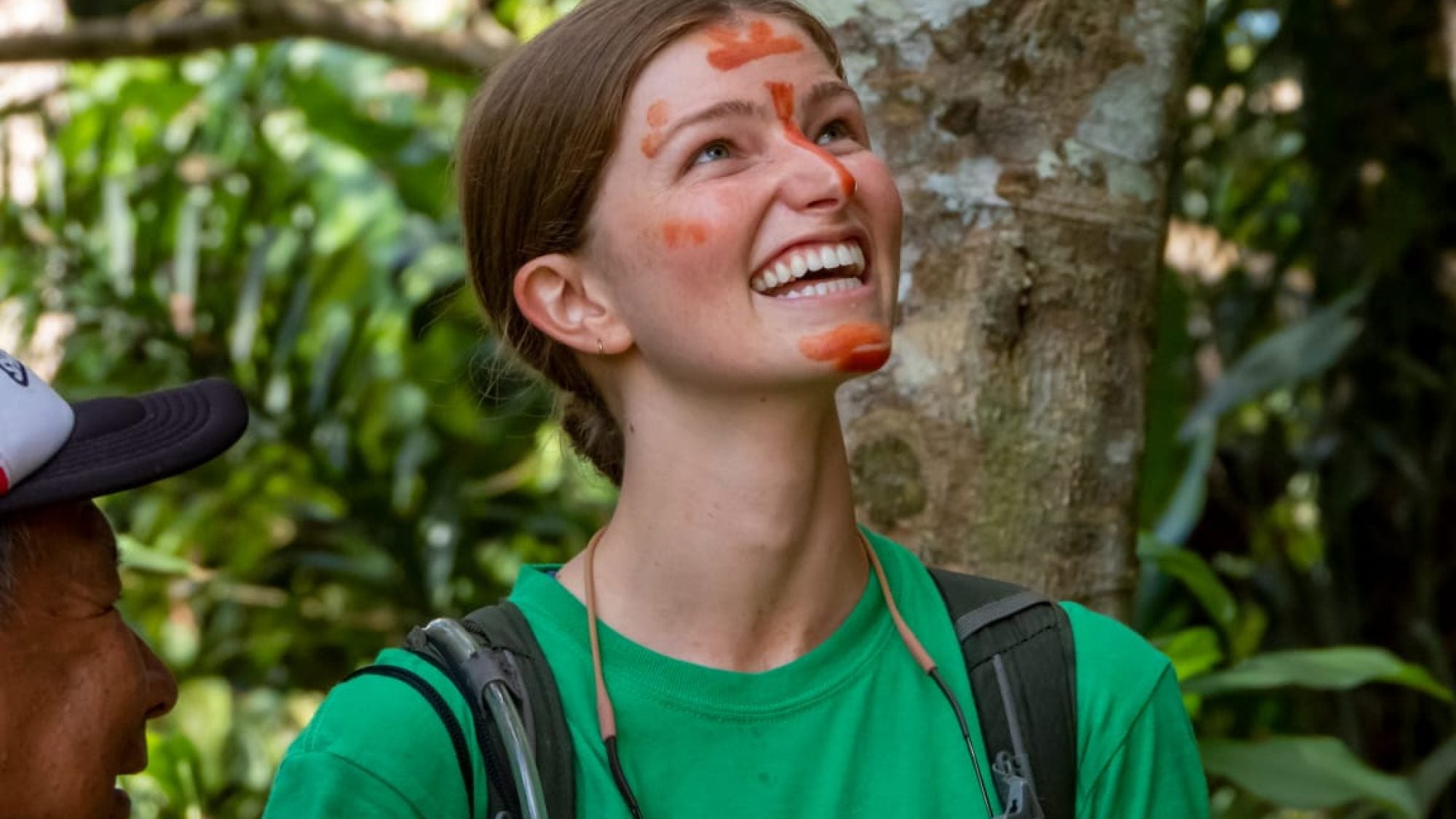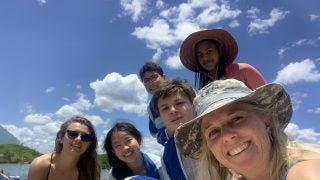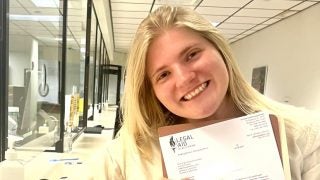When Mae Gleeson (G’23) wakes up in the morning, she’s not in her air-conditioned bedroom in Washington, DC. She’s laying on a one-inch sleeping pad in a cramped tent in the middle of the Amazon rainforest in the sweltering heat and humidity.
After months of preparing to survive in the Amazonian rainforest, Gleeson was finally in the thick of her summer adventure.
For three weeks in July, Gleeson and her team — led by Brian Griffiths, an assistant teaching professor in the Earth Commons, and in conjunction with the Amazon Center for Environmental Education and Research, OnePlanet, the Detroit Zoological Society and the Maijuna Federation — ventured into the rainforest to study mammalian species in the Amazon.
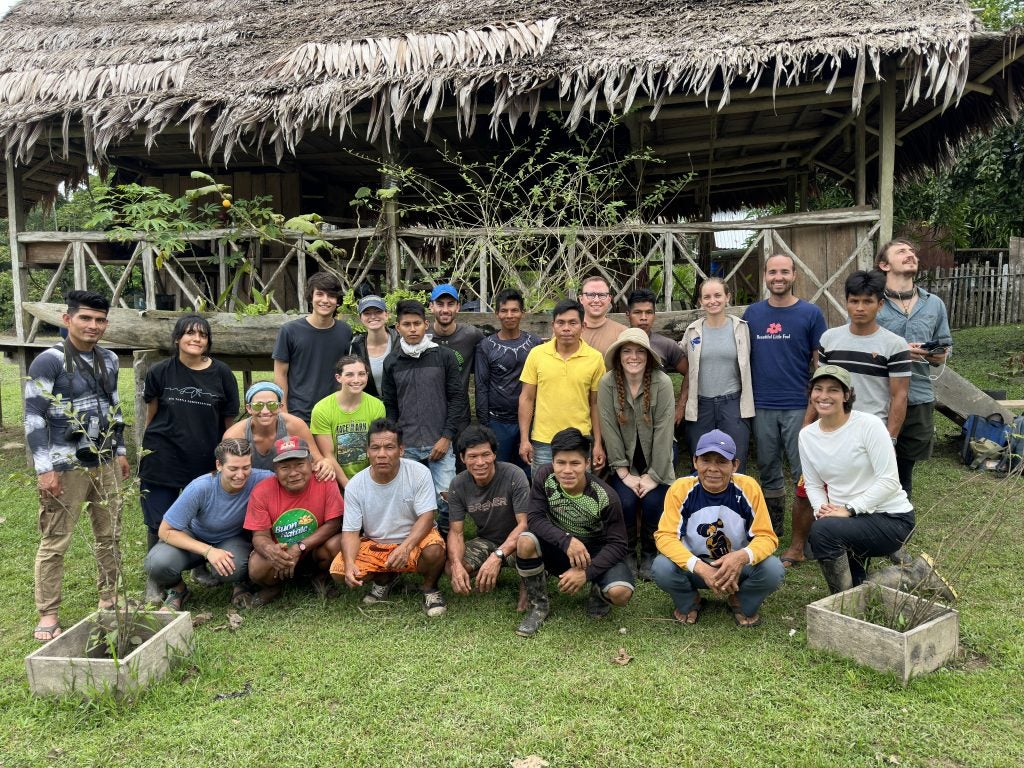
Working side-by-side with the Indigenous Maijuna community, Gleeson trekked miles into the wilderness every day to set up cameras to record wildlife activity. She waded in swamps, rowed upstream through creeks and foraged through dense foliage hiding snakes, insects and other animals.
We asked Gleeson to recap her three weeks in the rainforest. Read on to explore what her typical day was like in the Amazon.
A Day in the Life of Living in the Amazon
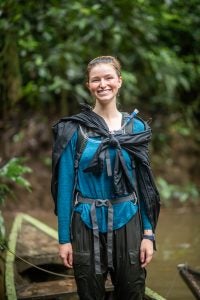
5:15 a.m. My first alarm starts to ring. I open my eyes and stare up at my tent. It’s still dark outside, but once I’m awake, it’s impossible to fall back asleep. The air is hot and humid, maybe around 85 degrees Fahrenheit, and I hear chatter outside from the Maijuna who were awake even earlier to start breakfast.
Leading a research expedition of 25 researchers, conservationists and Maijuna experts to the heart of the Peruvian Amazon demands exhaustive planning, and every morning I’m still amazed when the reality of where I am hits me. I roll off of my sleeping pad and start to organize my day pack. The excitement kicks in when I begin thinking about what kind of adventure today holds.
6:00 a.m. Once I’ve thrown on some clothes, packed up my gear and slid into my knee-high rubber boots — my trusty venomous snake safety guards — I head down the hill to eat some breakfast. There is a lineup of four large metal pots. Rice occupies one, while another contains warmed canned tuna and a third houses a hearty helping of lentils. I fill my tupperware with a bit of each and top it with a hard-boiled egg. Protein is the name of the game while in the field.
I look around to see my whole team fueling up for a long day of work. Josh is drinking instant coffee out of what looks like an old plastic takeout container. Meanwhile, Ellen’s perfecting her signature “Chunky Oat Latte,” adding a dash of instant coffee to soupy oatmeal. I laugh while observing this quirky morning ritual. Laughter comes easily out here. It’s a mix of genuine enjoyment from the challenging work and the great camaraderie, mingled with a hint of exhaustion-induced giddiness.
7:00 a.m. We’ve just finished planning which camera traps will be placed inside the Maijuna-Kichwa Regional Conservation Area today. Laden with gear and enthusiasm, we pile into peque-peques — traditional wooden motor boats — with our Maijuna leaders. A noteworthy detail: There’s been a dry spell for about a day, and everyone seems a bit nervous about the river’s water levels. Without a good dose of rain, navigating upstream to our designated trailheads becomes a bit of a challenge.
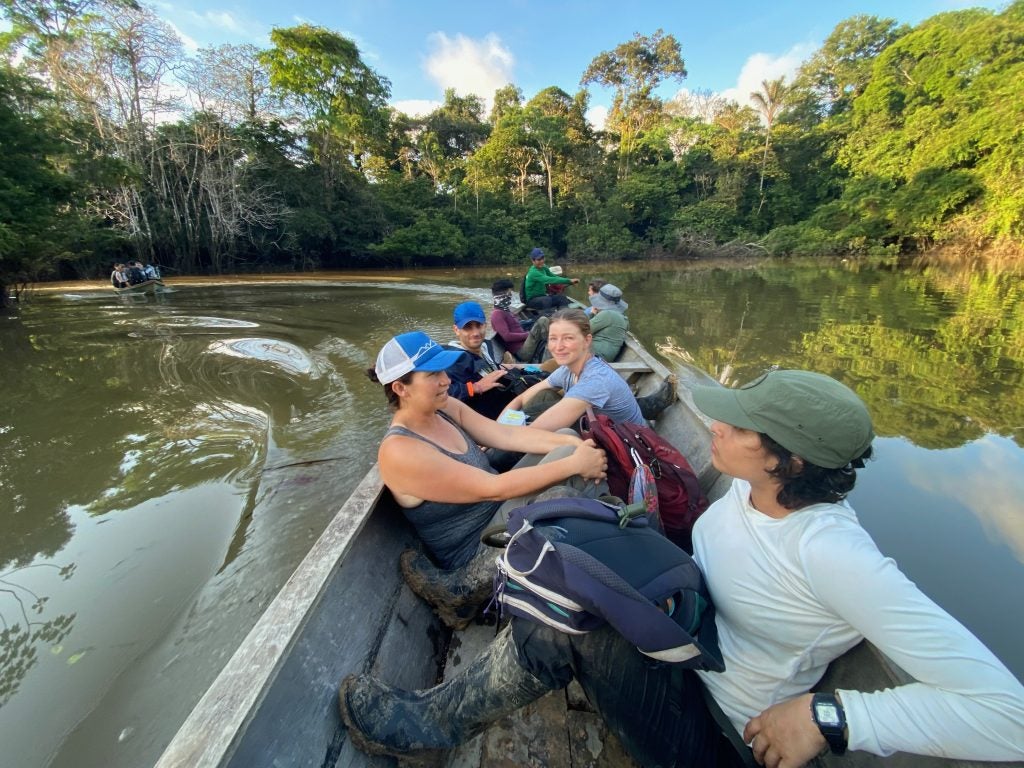
8:00 a.m. It’s been one hour of painfully slow movement by boat. We’ve been stopping every five minutes for a guide to get out and chainsaw a fallen tree in half that’s blocking our path.
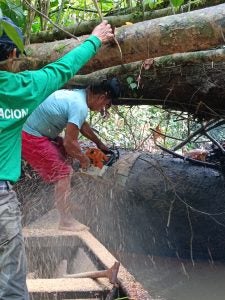
8:15 a.m. Brian and Ellie decide that it’s time to reassess our plans for the day after making slow progress. We reorganize teams for treks that are closer to our campsite and can be finished within the hours of daylight left. After a quick reshuffling of teams and a bit of boat-hopping, we’re back on the move with a revamped game plan.
9:20 a.m. My team of five researchers and four Maijuna guides finally arrive at the beginning of our trail and start the rugged 8-kilometer trek to place two camera traps. Trekking through the Amazon is a study in contrasts — a slow process until it’s suddenly not. The rainforest is incredibly dense and offers passage only to those with the right tools. This means progress can be measured in a crawl: A mere 1 kilometer might take two hours of our time. And let’s not forget the joys of river and swamp crossings.
In the forest, we follow the Maijuna like lifelines. When they prompt us to run, we sprint. When they say the words avispa (wasp) or vibora (snake), we don’t linger. The expertise they have in navigating this terrain is paramount to our safety.
We’ve barely begun our trek when I hear commotion from behind me. While I somehow managed to move swiftly past a beehive, Ale and Ava got caught in the crossfire between bee and machete. Now the bees are swarming them both. They bury themselves in Ale’s hair and circle Ava’s face while both swat at them frantically. I stand there shocked not knowing whether to help or walk cautiously away. When Justo opts for the latter, my feet follow suit in a heartbeat.
We make it 30 meters before stopping. Since these bees are a stingless species, Alejandra and Ava emerge unscathed. Yet Ale’s face bears the expression of unexpected guilt — stemming from the necessary demise of a few of their tiny assailants. Such are the quirks of our rainforest treks.
11:30 a.m. The GPS indicates that we’ve arrived within 100 meters of our first camera trap placement and we inform our Maijuna leaders Justo, Langer, Jonas and Agapito. They can begin to search for wildlife trails that will inform where we should set up our camera. I’m always amazed by their uncanny ability to inform us of the exact location and specific animal of the game trail they find. After identifying a tree, the Maijuna use a machete to clear an area around the camera’s field of view.
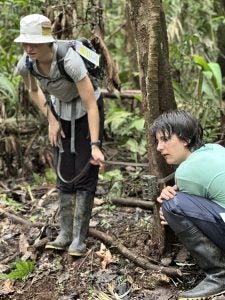
Time is of the essence, so Ava and I begin to program the camera settings. Once ready, we secure the device tightly to our tree while Ale and Cynthia jot down some necessary data points: longitude and latitude, number of fruiting palms, proximity to nearest water source and more. These details are logged to provide context and help explain any anomalies we observe in the recorded footage. We all pile in front of it for a selfie as the camera takes its first photo. I can’t wait to someday see the compilation of these photos across the 60 cameras we’ll be placing.
3:00 p.m. After placing our second camera, we begin the brisk journey home. Agapito has been trailing ever so slightly behind us for most of the day.
Due to the lack of precipitation over the past few days, Agapito has taken it upon himself to burn every Huicungo, a common tree in the Peruvian rainforest, that we’ve walked past today. In Maijuna culture, it’s believed that burning these trees can bring rain when it’s needed most, owing to the rain-like sound Huicungos make when they burn.
As the crackling of the tree begins, we hear him shouting “Lluvia, lluvia, lluvia!” His methods are working. The sky begins to darken fast, and we hear the sound of intense thunder in the distance. Agapito emerges from behind us and with a wide smile he simply states, “Lluvia,” or rain.
Brian glances at the team, and we can sense the urgency. “It’s about to rain buckets; we need to move,” he says. The next two hours are a frenzy of fast walking, boots drowning in mud, sideways winds, the sound of falling trees and soaking wet raincoats.
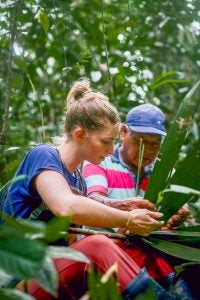
5:00 p.m. Finally back at camp, we assess the damage of Agapito’s much-needed storm. Despite our collective effort to secure rain flies, some tents are now ponds. Nylon is no match for an Amazonian rainstorm. Adding to the post-storm spectacle, a once-mighty 20-meter tree lies fallen. A stroke of luck places it neatly between our two clusters of tents. It’s a precarious situation, yet we greet it with laughter, a testament to the team’s indomitable spirit.
Tired, I begin to settle in for the night. First comes the river bath party where we wash off all the dirt and mud from the day, only to cover ourselves in mud once again when we clamber out of the river. Next, we eat a hardy meal of rice, plantains and the day’s catch: majás, a lowland paca or small rodent, courtesy of the Maijuna’s morning hunt.
Before bed, I venture into a procedure that every team member has experienced at least once by now — the meticulous extraction of spines from my hand, a memento from a muddy fall earlier in the day into one of the many thorny trees that dot across the jungle.
7:00 p.m. I say goodnight to the full team apart from Stephane, who has decided to spend his free night hours on a spearfishing escapade. He just needs to convince the Maijuna to lend him a spear and canoe. Easy enough, right? Finally, I climb back onto my sleeping pad and begin the slow process of falling asleep. Despite the challenges each day brings, I feel so lucky to embrace it all again tomorrow.
